Proof and perception
III
(Suite)
by
Michael Otte
Institut für Didaktik der Mathematik
Bielefeld, Germany
Problem 1
Our first problem is taken from S. Papert's book
"Mindstorms" (Basic Books 1980, 146):
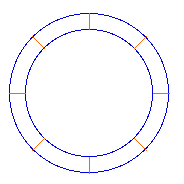 "Imagine
a string around the circumference of the earth, which for
this purpose we shall consider to be a perfectly smooth
sphere, four thousand miles in radius. Someone make a
proposal to place the string on six-foot-high poles. "Imagine
a string around the circumference of the earth, which for
this purpose we shall consider to be a perfectly smooth
sphere, four thousand miles in radius. Someone make a
proposal to place the string on six-foot-high poles.
Obviously this implies that the string
will have to be longer. A discussion arises about how
much longer it would have to be.
Most people who have been through high
school know how to calculate the answer. But before doing
so or reading on try to guess: Is it about one thousand
miles longer, about a hundred, or about ten?"
Papert then suggest looking first for a similar but
simpler version:
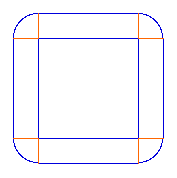 "A
good general rule for simplification is to look for a
linear version. Thus we pose the same problem on the
assumption of a 'square earth'". "A
good general rule for simplification is to look for a
linear version. Thus we pose the same problem on the
assumption of a 'square earth'".
Increasing the size of the square does not change the
quarter-circle slices, such that the extra string needed to
raise a string from the ground to height h is the
same for a very small square earth as for a very large one.
This solves the problem.
The amount of extra string needed is
(2ph). Papert himself says
that the purpose in working on the problem is not "to get
the right answer", but to "look sensitively for conflict
between different ways of thinking about the problem"
(ibid.).
|
A different way and perhaps, more consistently,
Leibniz might suggest as a linear version:
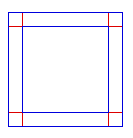
|
But Papert
wants to continue, thus:
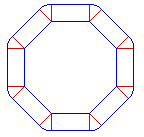
|
Nevertheless, both may point to the fact that their idea
shows that the size of the "earth" makes no difference to
how much extra string is needed. That eventually solves the
problem. Thus both ideas, let us call them Cur, (the idea of
curvature) and Lin (the idea of linearity) respectively
appear equivalent with respect to the problem at hand.
Drag the green
point
|
But both ideas yield more.
Lets start with the Leibniz version and lets for
every polygon (square, octagon...) call the
shortest distance from the center to the perimeter
the radius of that regular polygon. Increasing the
radius by h increases the length of the perimeter
by "the perimeter of a similar polygon of radius
h". This is exactly the linearity of the function
represented by the geometric form itself. The whole
is the sum of its parts: If the radius grows from x
to (x+h) the perimeter increases from f(x) to
f(x)+f(h). Therefore we have
f(x+h) = f(x) + f(h) and f(o) = o. The perimeter of
a polygon is a linear function of its radius. And
the principle of continuity yields the same result
for the circle (remember that Leibniz was the first
to systematically employ this principle). The
important thing is that you can read this fact
directly off from the geometric figures.
|
You can see with your own eyes that the enlargement of the
perimeter is represented again by a polygon of the same
shape. To derive another, more constructive than descriptive
representation of the linear function, Leibniz would point
to the fact that the shape of the polygon is not changed by
putting the string around on poles (i.e. enlarging the
radius by h).
 et y = f(x) = c.x
et y = f(x) = c.x
Both ways give an illustration of the idea of a
formbased conceptualization.
The potentialities of the Papert's idea Cur can only be
appreciated as soon as one considers the algebraic
expression y = c.x as the new and relevant shape. Different
from Leibniz we then get one and the same linear function y
= 2p.x for all types of "earth's"
(in fact the perimeter may be any smooth closed curve
without self-intersection). The proportionality factor
1.(2p) gives the number of full
circles which the heads of the poles run through when
following the curve. Therefore alternative values of c would
be (n.(2p) (n being any integer)
and from the discreteness of the range we understand
immediately that small deformations of the curve cannot
change the value of c. The geometric object in question is
no longer the curve, but a vector field along a curve. The
integer n is usually called the index of that vector field
with respect to the curve. The index will not change as long
as deformations of the curve do not pass through a zero of
the vector field.
We might derive from this an easily
understandable argument justifying Brouwer's Fixed-Point
Theorem.
Both approaches solve problem 1 and from this point of
view appear as equivalent. We shall now present a second
problem with respect to which the ideas Cur and Lin will
prove inequivalent. We take this problem (a problem about
the epicycloid) from Robert Davis' book "Learning
Mathematics" (Croom Helm, London 1984, 216pp.).
Problem 2
"In a recent ETS test, one question dealt with a
small circle that rolls, without slipping, around the
outside of a larger circle. (Thinking of them, if you
wish, as gears.) The radius of the large circle is three
times the size of the radius of the small circle. ... How
many times do we see the small circle revolve ..."
Drag the green
point
Bob Davis continues:
"The experts apparently reasoned essentially as
follows: if the radius of the larger circle is three
times as great, then the perimeter is three times as
great. 'Rolling without slipping' means that the
arc-lengths are equal. Since the arc-length s is the
product of radius times central angle, the angle for the
little circle must be three times as great as the angle
for the larger circle. But the angle on the large circle
must increase by 2p;
therefore, the angle for the small circle must increase
by 3.2p = 6p,
and the small circle revolves (or 'turns', or 'rotates')
three times. This answer is wrong".
 Obviously
the experts tried to use idea Lin. Let us therefore see
which results idea Cur will produce We thus again replace
the larger circle by a quadrangle. We see immediately (fig.
6) that at the four corners the smaller circle rotates
without making progress along the circumference of the
larger figure. By replacing the larger circle by the
quadrangle we become able to perceive that two different
rotations are superimposed in the motion of the smaller
circle. The quadrangle separates, so to speak, these two
movements of the smaller circle. As it rotates by an angle
of 90° at each of the 4 corners, we immediately
understand that the correct answer must be, four
times! Obviously
the experts tried to use idea Lin. Let us therefore see
which results idea Cur will produce We thus again replace
the larger circle by a quadrangle. We see immediately (fig.
6) that at the four corners the smaller circle rotates
without making progress along the circumference of the
larger figure. By replacing the larger circle by the
quadrangle we become able to perceive that two different
rotations are superimposed in the motion of the smaller
circle. The quadrangle separates, so to speak, these two
movements of the smaller circle. As it rotates by an angle
of 90° at each of the 4 corners, we immediately
understand that the correct answer must be, four
times!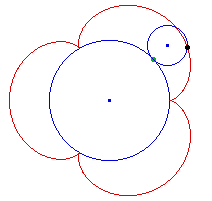
A point of the smaller circle describes an
epicycloid which has 3 "leaves" (fig. 7). This is what idea
Lin tells us. That the experts must have used this idea and
misapplied it because they neglected the curvature or rather
the two different rotations of the smaller circle is also
suggested by Bob Davis.
For the sake of completeness we present Davis'
solution:
"In [the following figure], C is the
center of the small circle in the starting position. A
moment after the motion starts, the center has moved to
C'. Because of non-slipping, arc BA' on the small circle
has the same arc-length as arc AB on the large circle.
Therefore angle BC'A' is three times the size of angle
AOB. But, the moment we have available to us a
non-rotating reference line, PC', that translates so as
always to pass through the center of the smaller circle,
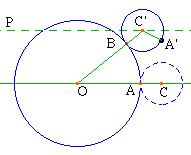 we
see easily that angle BC'A' is NOT the angle through
which the small circle has rotated. Instead, angle PC'A'
is. The rest of the solution in now routine ... The small
circle revolves -- or rotates, or turns -- exactly four
times. ... Notice that the wrong representation comes
close to being right. If a bicycle wheel that has a
perimeter of 87 inches rolls without slipping along a
flat sidewalk, and covers a distance of 3.87 = 261
inches, then the wheel will have rotated exactly three
times. Presumably some cognitive representation of this
phenomenon was retrieved, or constructed, by the experts,
so that they all agreed - on the wrong answer" because of
using idea Lin only. we
see easily that angle BC'A' is NOT the angle through
which the small circle has rotated. Instead, angle PC'A'
is. The rest of the solution in now routine ... The small
circle revolves -- or rotates, or turns -- exactly four
times. ... Notice that the wrong representation comes
close to being right. If a bicycle wheel that has a
perimeter of 87 inches rolls without slipping along a
flat sidewalk, and covers a distance of 3.87 = 261
inches, then the wheel will have rotated exactly three
times. Presumably some cognitive representation of this
phenomenon was retrieved, or constructed, by the experts,
so that they all agreed - on the wrong answer" because of
using idea Lin only.
Like Papert's analysis of problem 1, this presentation of
problem 2 is very strongly influenced by the traditional
concern for formulas. The Leibnizian alternatives, in
contrast, are more interested in relational structure and
intuitive objects.

(Back to the first page)
Cabri Java Project

|

![]()

![]()